What’s Up?
On Thursday, Anita North and I spent about six hours at a feeder set-up in Anchor Point, AK photographing Pine Grosbeak, Boreal Chickadee, Common Redpoll, and Red-breasted Nuthatch. It was cloudy all day with rain showers off and on. We ended up very wet, but we had a ton of fun and made some good images. We have two more days with the songbirds. Photos tomorrow. The first day of the first Homer/Kachemak Bay Bald Eagle IPT is Sunday. Then it will be eagles, eagles, and more eagles. Speaking of which, we had two adult Bald Eagles in the parking lot at Land’s End Resort, and three completely tame and very handsome juveniles foraging in the parking lot at McDonalds.
Today is Friday 18 February 2022. The forecast is for dry! Wherever you are, and whatever you are doing, I hope that you too have a great day. This blog post took about an hour to prepare (including the time spent on the two image optimizations), and makes 96 days in a row with a new one.
You can find some great photo accessories (and necessities, like surf booties!) on Amazon by clicking on the Stuff tab on the orange/yellow menu bar above. On a related note, it would be extremely helpful if blog-folks who, like me, spend too much money on Amazon, would get in the habit of clicking on the Amazon logo link on the right side of each blog post when they shop online. As you might expect, doing so will not cost you a single penny, but would be appreciated tremendously by yours truly. And doing so works seamlessly with your Amazon Prime account.
Please remember that if an item — a Delkin flash card, or a tripod head — for example, that is available from B&H and/or Bedfords, is also available in the BAA Online Store, it would be great, and greatly appreciated, if you would opt to purchase from us. We will match any price. Please remember also to use my B&H affiliate links or to earn 3% cash back at Bedfords by using the BIRDSASART discount code at checkout for your major gear purchases. Doing either often earns you free guides and/or discounts. And always earns my great appreciation.
Recovered Image Alert
Both of the images featured in today’s post were among the 135,000+ recently recovered images. 🙂
|
|
Image #1: Photo Mechanic screen capture for the Royal Tern with wings raised image |
The Problem
My main problem with this image is the breaking wave just above the bird’s left wing near the right frame edge … Removing the wave would be somewhat problematic as it merged with the bird’s wing.
What’s Remarkable?
I came across this image when I was reviewing the April 2021 folder. Seeing how sharp the image was, I assumed that it was created with the Sony 600 GM and the 1.4X TC. When I checked in A7INFO, I was stunned to learn that it was made with the 200-600 G lens and the teleconverter. Most folks assume incorrectly that images made with a G lens and a teleconverter could never be as sharp as those made with a far more expensive GM (Grand Master) lens and the 1.4X teleconverter. In short, sharpness with the 200-600 G lens and a TC is amazing; it is pretty much impossible to find any differences. That means that when you purchase a 600mm f/4GM lens you are paying for speed (f/4 vs. f/6.3) rather than sharpness.
Working with mirrorless bodies with a 1.4X TC on telephoto zoom lenses is a viable option especially when working with lots of light. Heck, I have published images here made with the Canon R5/RF 100-500/2X III TC and with the Sony A1/200-600 G/2X rigs. All were created in full sun, and all were remarkably sharp.
|
|
Image #1A: RawDigger screen capture for the Royal Tern with wings raised image |
Near-Perfect
Had this been a perfect exposure, the GREEN histogram would have reached the 8000 2/3 line. Being just short of that, this exposure is within 1/6 stop of being perfect.
RawDigger — not for the faint of heart …
Nothing has ever helped me learn to create perfect exposures to the degree that RawDigger has. I think that many folks are reluctant to learn that most of their images are underexposed by one or more full stops and that highlight warnings in Photoshop, Lightroom, Capture One, and your in-camera histogram are completely bogus as they are based on the embedded JPEGs. Only your raw files tell the truth all the time. Heck, I resisted RawDigger for several years … Once you get over that feeling, RawDigger can become your very best exposure friend no matter what system you are using. On the recent IPTs and In-the-Field sessions, we have demonstrated that fact. Convincingly.
The RawDigger (pink) Adapted Histogram
In the RawDigger e-Guide, you will learn exactly how to set up the Adapted “pink” RawDigger Histogram and how to use it to quickly and easily evaluate the exposure or raw file brightness of images from all digital cameras currently in use. RawDigger was especially helpful to me when I struggled with R5 exposures and when learned my new camera body, the Sony Alpha a1.
|
|
RawDigger e-Guide with Two Videos |
The RawDigger e-Guide with Two Videos
by Arthur Morris with Patrick Sparkman
The RawDigger e-Guide was created only for serious photographers who wish to get the absolute most out of their raw files.
Patrick and I began work on the guide in July 2020. At first we struggled. We asked questions. We learned about Max-G values. We could not figure out why the Max G values varied by camera system. IPT veteran Bart Deamer asked lots of questions that we could not answer. We got help from RawDigger creator Iliah Borg. We learned. In December, Patrick came up with an Adapted Histogram that allows us to evaluate the exposures and raw file brightness for all images created with all digital camera bodies from the last two decades. What we learned each time prompted three complete beginning to end re-writes.
The point of the guide is to teach you to truly expose to the mega-Expose-to-the-Right so that you will minimize noise, maximize image quality, best utilize your camera’s dynamic range, and attain the highest possible level of shadow detail in your RAW files in every situation. In addition, your properly exposed RAW files will contain more tonal information and feature the smoothest possible transitions between tones. And your optimized images will feature rich, accurate color.
We teach you why the GREEN channel is almost always the first to over-expose. We save you money by advising you which version of RawDigger you need. We teach you how to interpret the Max G values for your Canon, Nikon, and SONY camera bodies. It is very likely that the Shock-your-World section will shock you. And lastly — thanks to the technical and practical brilliance of Patrick Sparkman — we teach you a simple way to quickly and easily evaluate your exposures and raw file brightness using an Adapted RawDigger histogram.
The flower video takes you through a session where artie edits a folder of images in Capture One while checking the exposures and Max-G values in RawDigger. The Adapted Histogram video examines a series of recent images with the pink histograms and covers lots of fine points including and especially how to deal with specular highlights. The directions for setting up the Adapted Histogram are in the text.
If we priced this guide based on how much effort we put into it, it would sell it for $999.00. But as this guide will be purchased only by a limited number of serious photographers, we have priced it at $51.00. You can order yours here in the BAA Online Store.
|
|
|
This image was created on 26 April 2021 at Fort DeSoto Park, Tierra Verde, CA. I used the hand held Sony FE 200-600mm f/5.6-6.3 G OSS lens with the Sony FE 1.4x Teleconverter (at 840mm) with the One, the Sony a1 Mirrorless Camera. ISO 800. Exposure was determined by Zebras with ISO on the thumb wheel: 1/1600 sec. at f/11 (stopped down 2/3 stop) in Manual mode. RawDigger confirmed that the RAW file was perfect. AWB at 7:55:06am on a sunny day. Tracking: Spot S Bird Face/Eye Detection AF-C was active at the moment of exposure and performed perfectly. Click on the image to enjoy the high-res version. Image #1B: Royal Tern with wings raised; the optimized version |
The Image Optimization
The image optimization was fairly straightforward. As mentioned above, elminating the breaking wave on the right frame-edge required some care. Working fairly large, I created a Quick Mask about 1/3 of the size of the whitish area. I moved it to the right and added a Regular Layer Mask. Working even larger, I refined the mask by painting the away the mask where it covered the wing. If I painted outside the line, I hit X and painted the background back in as needed. I repeated those steps twice more until the entire whitish area was covered and the merge with the wing looked pretty good. Remember: it is easy to find fault when you know what has been done. 🙂 The last step was to smooth the repaired background by running a 65 pixel Gaussian Blur on the whole image, adding a Hide-all, Black, or Inverse Layer Mask, and painting the blur in on the background with a large 50% opacity brush, being sure to stay well away from the bird. Last was a bit of bill clean-up at the base of the tern’s bill.
The breeding plumage Royal Terns are often the starts of the show on the Spring DeSoto IPTs.
Stuff You Will Learn on an IPT While Creating and Optimizing Images Like This One
- The importance of getting your butt damp to move the background farther from the subject so as to create lovely, smooth, out-of-focus backgrounds.
- How to get the right exposure in full sun.
- Image design basics; creating pleasing super-tight images.
- Recognizing the good and great situations
- Picking your keepers/looking for that something special — the raised wings in this case.
- Head angle fine points (for birds facing you!).
- The importance of working on sun angle: Image #2.
- Getting close to free and wild birds on the open beach
- Isolating the subject
- Working with teleconverters
- Converting your Raw files: both images.
- Creating and using Quick Masks (and lots more Photoshop techniques).
|
|
|
Fort DeSoto in spring is rife with tame birds, many in full breeding plumage. Click on the composite to enjoy a larger version. Clockwise from upper left around to center: Laughing Gull landing on head of Brown Pelican, Laughing Gull in flight, Reddish Egret sunrise silhouette, Great Blue Heron with needlefish, Yellow-crowned Night Heron with ghost crab, Roseate Spoonbill, Sanderling in breeding plumage, and white morph Reddish Egret in glorious breeding plumage. |
The 2022 DeSoto Spring IPT/April 26 through the morning session on April 29, 2020. 3 1/2 DAYS: $2099.00. Limit: 6 photographers/Openings 5
Fort DeSoto, located just south of St. Petersburg, FL, is a mecca for breeding terns and gulls and wading birds in spring. Migrant shorebirds are in abundance, and many are exceedingly tame. We should have great chances on Royal and Sandwich Terns and both white- and dark-morph Reddish Egrets. Great Egret, Snowy Egret, Great Blue Heron, Tricolored Heron, and White Ibis are easy as well and we will almost surely come up with a tame Yellow-crowned Night-Heron or two along with some American Oystercatchers. We will enjoy lots of great flight photography.
|
|
|
Again, Fort DeSoto in spring is rife with tame birds, most in breeding plumage. Click on the composite to enjoy a larger version. Clockwise from upper left around to center: Laughing Gull in flight, Yellow-crowned Night-Heron, Sandwich Terns copulating, Roseate Spoonbill, Great Egret with reflection, breeding plumage Short-billed Dowitcher, American Oystercatcher, Royal Tern, white morph Reddish Egret, and Snowy Egret in marsh. |
We will also get to photograph a variety of other shorebirds including Black-bellied, Semipalmated, Wilson’s, and Piping Plovers, Willet, Dunlin, Short-billed Dowitcher, most especially, Red Knot with many individuals in their handsome breeding plumages. In spring the T-shaped peninsula and the newly formed sandbar, Outback Key, are literally packed with avian treasures.
With luck, we might get to photograph one of Florida’s most desirable species: Roseate Spoonbill. And we will almost surely get to do some Brown Pelican flight photography. With luck, they will have Laughing Gulls landing on their heads. And though not guaranteed, Wood Stork might well be expected. And we will be on the lookout for a migrant passerine fallout in the event of a thunderstorm or two.
|
|
|
Yes, Fort DeSoto in spring is rife with tame birds, most in breeding plumage. Click on the composite to enjoy a larger version. Clockwise from upper left around to center: breeding plumage Dunlin, dark morph Reddish Egret displaying, Laughing Gull vertical front-end portrait, Laughing Gull with prey item, landing on head of Brown Pelican, breeding plumage Royal Tern displaying, Royal Terns — pre-copulatory stance, Laughing Gulls copulating, Laughing Gull head portrait, breeding plumage Sandwich Tern with fish, and a rare treat, a breeding plumage White-rumped Sandpiper. |
On the IPT you will learn:
- 1- The basics and fine points of digital exposure; how to get the right exposure every time after making a single test exposure (or before if you are using SONY gear).
- 2- How and why to work in Manual mode (even if you’re scared of it).
- 3- How to approach free and wild birds without disturbing them.
- 4- Lots about bird behavior and how to use that knowledge to help you create better images.
- 5- To age and identify many species of shorebirds including sandpipers, plovers, dowitchers, and possibly yellowlegs.
- 6- To spot good situations and to choose the best perspective.
- 7- To see, evaluate, and understand the light.
- 8- To design pleasing images by mastering your camera’s AF system.
- 9- And perhaps most importantly, to evaluate wind and sky conditions and understand how they affect bird photography.
- 10- How and when to access the magical sandbar safely.
- 11- More than you could ever imagine.
|
|
|
You got it by now! Fort DeSoto in spring is rife with tame birds, most in breeding plumage. Click on the composite to enjoy a larger version. Clockwise from upper left around to center: Roseate Spoonbill, immature Brown Pelican in flight, the heron/egret hybrid, American Oystercatcher feeding, immature Royal Tern on railing, Great Egret morning silhouette, Black Skimmer in surf, and underside head portrait of Great Blue Heron. |
Morning sessions will run at least three hours, afternoon sessions 2 1/2. There is never a set schedule on an IPT — we adapt to the conditions. On cloudy mornings, when the photography is excellent, we may opt to extend the morning session and skip the afternoon, especially if the afternoon weather is not looking too good. There will be a Photoshop/image review session after lunch (included) each day. That will be followed by Instructor Nap Time. This IPT will run with only a single registrant (though that is not likely to happen). The best airport is Tampa (TPA). Once you register, you will receive an e-mail with lodging information. Do know that it is always best if IPT folks stay in the same general area — Gulfport in this case, rather than at home or at a friend’s place a good distance away.
Folks attending this IPT will be out in the field early and stay late to take advantage of sunrise and sunset colors; this is pretty much a staple on almost all BIRDS AS ART Instructional Photo-Tours. Doing so will often present unique photographic opportunities, opportunities that will be missed by those who need their beauty rest and those who need to get home for a proper dinner. I really love it when I am leaving the beach at 9:30am on a sunny morning after a great session just as a carful or two of well-rested photographers are arriving … We will be getting wet.
Credit cards are OK for your $500 deposit. You can register by calling Jim or Jennifer during weekday business hours at 863-692-0906 with a credit card in hand. After you leave the deposit, you will receive an e-mail with your balance statement and instructions for sending your balance check. If you wish to pay in full right off the bat, you can make your check out to BIRDS AS ART and send it via US mail here: BIRDS AS ART, PO BOX 7245, Indian Lake Estates, FL 33855. You will receive a confirmation e-mail with detailed instructions, and clothing and gear advice a month before the trip. Please shoot me an e-mail if you plan to register or if you have any questions.
Typos
With all blog posts, feel free to e-mail or to leave a comment regarding any typos or errors.

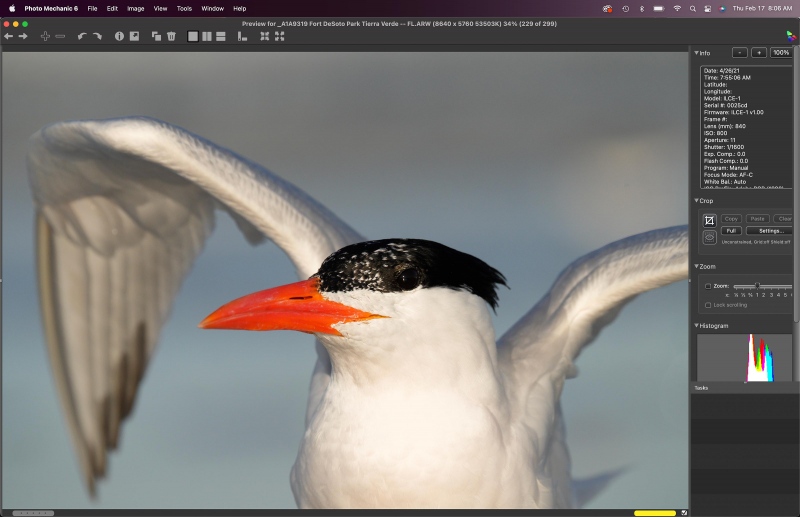
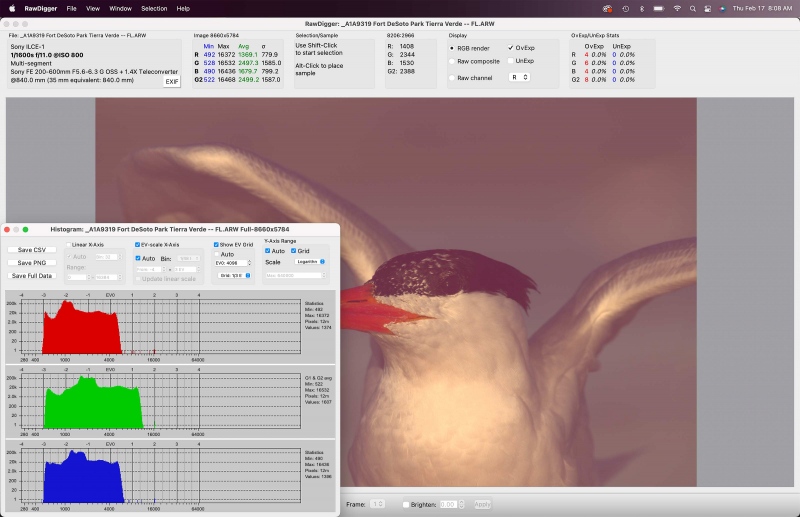

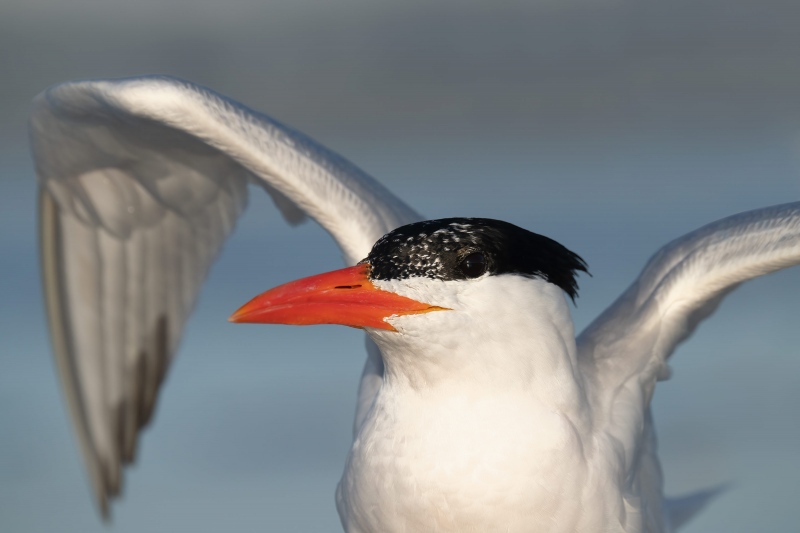
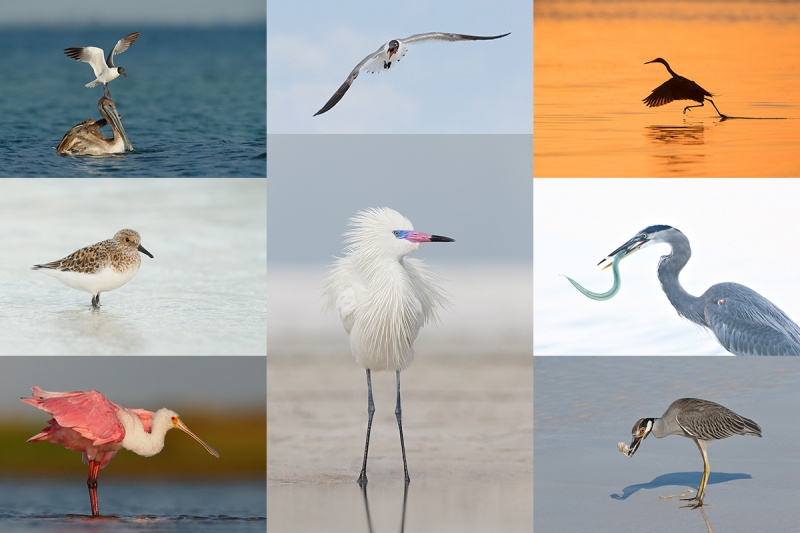
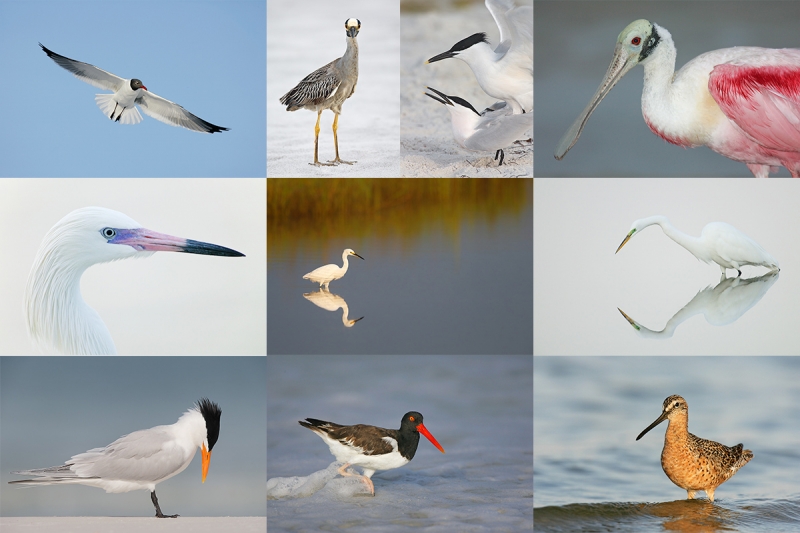
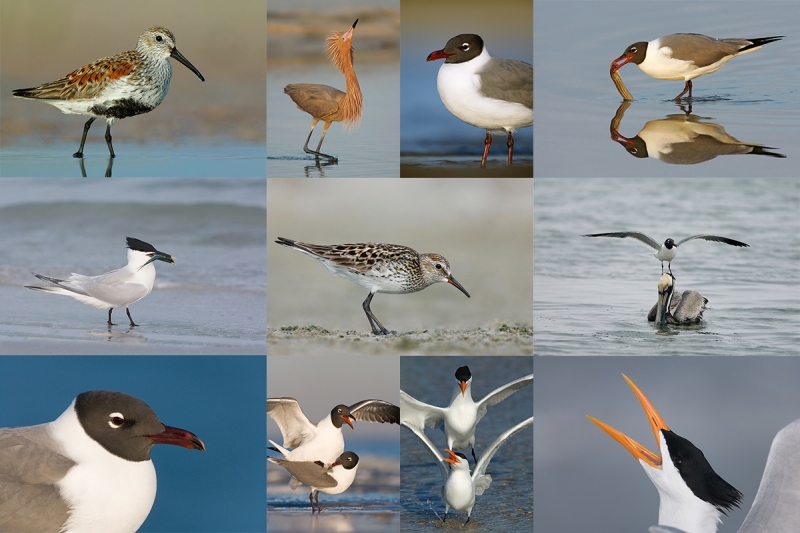
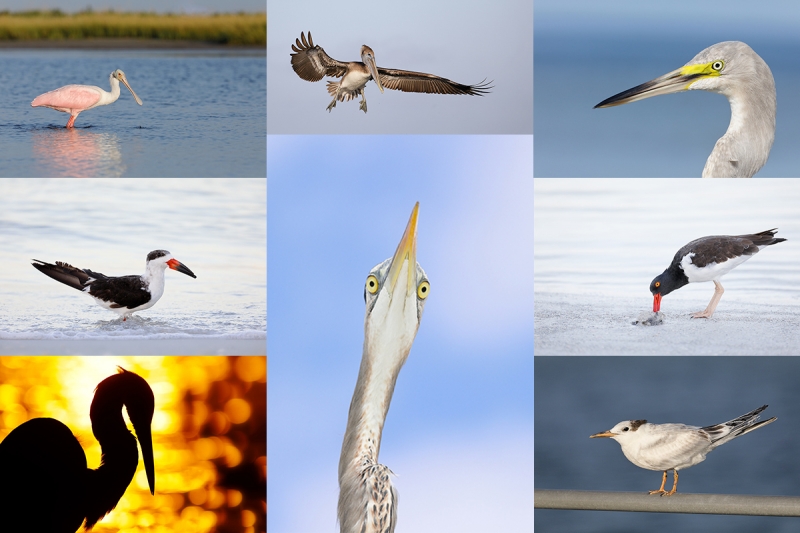













Hi Artie,
I like this interesting image and agree that optimization further improves it.
In the main body of your text you mention that the image was created with the 200-600mm G lens and 1.4X teleconverter. The stated focal length of 708mm supports this. However in the description under image 1B you state twice that the image was made with the Sony FE 600mm f/4 GM OSS Lens with converter.
I can see the eye of the bird on my monitor, but it does not stand out as I would like to see it. I have seen such virtual “disappearance” of eyes in some of my images and it does not represent what I recall seeing with my own eyes. I therefore brighten the eye and increase contrast in such images. I believe that this kind of adjustment improves the those images.
Hi Dietmar, It took me a while to fix the total screw-up here but I just did it — three weeks late. The image was made with the 200-600 and the 1.4X TC and the a1. At Fort DeSoto.
As far as the eye is concerned, when I view the high-re version on my MacBook Pro the eye stands out beautifully and is as clear as a bell …
with love, artie
Image 1 and 1B are good!! Only problem is that I can’t see a Royal Tern EYE!!!
Thanks, Sue. You may need a new monitor …
with love, artie